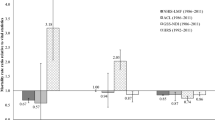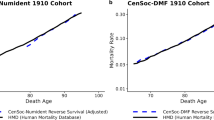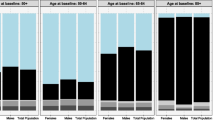Abstract
We examine inferences about old-age mortality that arise when researchers use survey data matched to death records. We show that even small rates of failure to match respondents can lead to substantial bias in the measurement of mortality rates at older ages. This type of measurement error is consequential for three strands in the demographic literature: (1) the deceleration in mortality rates at old ages; (2) the black-white mortality crossover; and (3) the relatively low rate of old-age mortality among Hispanics, often called the “Hispanic paradox.” Using the National Longitudinal Survey of Older Men matched to death records in both the U.S. Vital Statistics system and the Social Security Death Index, we demonstrate that even small rates of missing mortality matching plausibly lead to an appearance of mortality deceleration when none exists and can generate a spurious black-white mortality crossover. We confirm these findings using data from the National Health Interview Survey matched to the U.S. Vital Statistics system, a data set known as the “gold standard” (Cowper et al. 2002) for estimating age-specific mortality. Moreover, with these data, we show that the Hispanic paradox is also plausibly explained by a similar undercount.






Similar content being viewed by others
Notes
This law was first quantified in 1939, when Greenwood and Irwin (1939) found that the one-year probability of death at advanced age asymptotically approaches a limit of 0.44 for women and 0.54 for men. Such a law suggests that there may be no fixed upper limit to human longevity and thus no fixed maximal human lifespan (Gavrilov and Gavrilova 2006; Thatcher et al. 1998).
One could imagine an error process operating predominantly in the other direction, if deaths are recorded that do not occur. This could be called the “Twain effect” (per Mark Twain’s suggestion that “the report of my death was an exaggeration”). The Twain effect would cause underestimation of the denominator in subsequent years. Here again, consequent error would progressively worsen as the cohort ages. Later, we argue that this effect is not important in our application.
Preston et al. (1998) showed that when age is recorded in single years earlier in life (instead of five-year intervals), this virtually eliminates biases in ASMRs from age misreporting.
Yet another advantage of this approach is that longitudinal surveys often collect data on family and other contextual variables, which then allows researchers to assess relationships between early-life factors and subsequent mortality.
Readers may wonder why the vital statistics match used data through 2008 whereas the SSA Death Index is through 2012. Although we informally refer to the Census Bureau as “matching on the respondent’s Social Security number (SSN),” this is true only in an indirect sense. The Census Bureau matches on a personal identification key (PIK), which is a number that has a one-to-one match with the respondent’s SSN, to protect the confidentiality of respondents. All files used for matching must, therefore, contain this unique PIK for matching, a process known as “being PIKed.” At the time of our match, the most recent PIKed file from vital statistics was through 2008, whereas the files from SSA were through 2012.
For instance, in collecting data for the current NLS cohorts (the NLSY 1979 and NLSY 1997 cohorts), NORC requires interviewers’ proxies to provide either an obituary or a death certificate before recording a death.
We also estimated the measurement model with the VS08 match, and it performed equally well with those data.
Programs are available from the authors. Our procedure for limiting the measurement error to be between 0 and 1 entails the use of a logistic error model, specifying error to be α = e γ / (1 + e γ) and then allowing γ to differ for whites and blacks.
Specifically, the extinct generation approach stipulates that all missing deaths are Methuselah error, while the ME model estimates the rate of Methuselah error.
The number of person-years in our NHIS-NDI analysis is 119,007.
Biological models that allow for mortality deceleration in drosophila and other nonprimates may be quite different than the human biology of aging. Older theories, such as those that posit limits to cell replication, should perhaps be reconsidered.
References
Abraido-Lanza, A. F., Dohrenwend, B. P., Ng-Mak, D. S., & Turner, J. B. (1999). The Latino mortality paradox: A test of the “salmon bias” and healthy migrant hypotheses. American Journal of Public Health, 89, 1543–1548.
Allison, P. D. (1982). Discrete-time methods for the analysis of event histories. Sociological Methodology, 13, 61–98.
Arias, E. (2006). United States life tables, 2003 (National Vital Statistics Reports, Vol. 54, No. 14). Hyattsville, MD: National Center for Health Statistics.
Berkman, L., Singer, B., & Manton, K. (1989). Black/white differences in health status and mortality among the elderly. Demography, 26, 661–678.
Blewett, L. A., Rivera Drew, J. A., Griffin, R., King, M. L., & Williams, K. (2016). IPUMS Health Survey: National Health Interview Survey, Version 6.2. Minneapolis, MN: University of Minnesota. https://doi.org/10.18128/D070.V6.2
Coale, A. J., & Kisker, E. E. (1986). Mortality crossovers: Reality or bad data? Population Studies, 40, 389–401.
Cowper, D. C., Kubal, J. D., Maynard, C., & Hynes, D. M. (2002). A primer and comparative review of major U.S. mortality databases. Annals of Epidemiology, 12, 462–468.
Department of Commerce, Bureau of the Census. (1921). United States life tables: 1890, 1901, 1910, and 1901–1910. Washington, DC: U.S. Government Printing Office.
Dupre, M. E., Franzese, A. T., & Parrado, E. A. (2006). Religious attendance and mortality: Implications for the black-white mortality crossover. Demography, 43, 141–164.
Eberstein, I. W., Nam, C. B., & Heyman, K. M. (2008). Causes of death and mortality crossovers by race. Biodemography and Social Biology, 54, 214–228.
Gavrilov, L. A., & Gavrilova, N. S. (2006). Reliability theory of aging and longevity. In E. J. Masoro & S. N. Austad (Eds.), Handbook of the biology of aging (pp. 3–42). Burlington, MA: Academic Press.
Gavrilov, L. A., & Gavrilova, N. S. (2011). Mortality measurement at advanced ages: A study of the Social Security Administration Death Master File. North American Actuarial Journal, 15, 432–447.
Gompertz, B. (1825). On the nature of the function expressive of the law of human mortality, and on a new mode of determining the value of life contingencies. Philosophical Transactions of the Royal Society, 115, 513–583.
Greenwood, M., & Irwin, J. O. (1939). The biostatics of senility. Human Biology, 11, 1–23.
Hsu, Y.-C. (2012). Three essays on measurement and evaluation of mortality (Unpublished doctoral dissertation). Heinz College, Carnegie Mellon University, Pittsburgh, PA.
Johnson, N. (2000). The racial crossover in comorbidity, disability, and mortality. Demography, 37, 267–283.
Kannisto, V. (1994). Development of oldest-old mortality, 1950–1990: Evidence from 28 developed countries (Monographs on Population Aging, 1). Odense, Denmark: Odense University Press.
Kestenbaum, B. (1992). A description of the extreme aged population based on improved Medicare enrollment data. Demography, 29, 565–580.
Lariscy, J. T. (2011). Differential record linkage by Hispanic ethnicity and age in linked mortality studies: Implications for the epidemiologic paradox. Journal of Aging and Health, 23, 1263–1284.
Lynch, S. M., Brown, J. S., & Harmsen, K. G. (2003). Black-white differences in mortality compression and deceleration and the mortality crossover reconsidered. Research on Aging, 25, 456–483.
Manton, K. G., Poss, S. S., & Wing, S. (1979). The black/white mortality crossover: Investigation from the perspective of the components of aging. Gerontologist, 19, 291–300.
Manton, K. G., & Stallard, E. (1981). Methods for evaluating the heterogeneity of aging processes in human populations using vital statistics data: Explaining the black/white mortality crossover by a model of mortality selection. Human Biology, 53, 47–67.
Manton, K. G., & Stallard, E. (1984). Recent trends in mortality analysis. New York, NY: Academic Press.
Manton, K. G., Stallard, E., & Vaupel, J. W. (1984). Methods for comparing the mortality experience of heterogeneous populations. Demography, 18, 389–410.
Markides, K. S., & Coreil, J. (1986). The health of Hispanics in the southwestern United States: An epidemiological paradox. Public Health Reports, 101, 253–265.
Masters, R. K. (2012). Uncrossing the U.S. black-white mortality crossover: The role of cohort forces in life course mortality risk. Demography, 49, 773–796.
Minnesota Population Center State Health Access Data Assistance Center. (2016). Integrated Health Interview Series: Version 6.21. Minneapolis: University of Minnesota. Retrieved from https://nhis.ipums.org/nhis/
Myers, R. J. (1978). An investigation of the age of an alleged centenarian. Demography, 15, 235–236.
Nam, C. (1995). Another look at mortality crossovers. Social Biology, 42, 133–142.
National Center for Health Statistics. (2013). NCHS 2011 Linked Mortality Files matching methodology (Report). Hyattsville, MD: National Center for Health Statistics Office of Analysis and Epidemiology.
Oeppen, J., & Vaupel, J. W. (2002). Broken limits to life expectancy. Science, 296, 1029–1031.
Parnell, A. M., & Owens, C. R. (1999). Evaluation of U.S. mortality patterns at old ages using the Medicare enrollment data base. Demographic Research, 1(article 2). https://doi.org/10.4054/DemRes.1999.1.2
Patel, K. V., Eschbach, K., Ray, L. A., & Kyriakos, S. (2004). Evaluation of mortality data for older Mexican Americans: Implications for the Hispanic paradox. American Journal of Epidemiology, 159, 707–715.
Preston, S. H., & Elo, I. T. (2006). Black mortality at very old ages in official US life tables: A skeptical appraisal. Population and Development Review, 32, 557–566.
Preston, S. H., Elo, I. T., Hill, M. E., & Rosenwaike, I. (2003). The demography of African Americans 1930–1990. Dordrecht, the Netherlands: Springer.
Preston, S. H., Elo, I. T., Rosenwaike, I., & Hill, M. (1996). African-American mortality at older ages: Results of a matching study. Demography, 33, 193–209.
Preston, S. H., Elo, I. T., & Stewart, Q. (1998). Effects of age misreporting on mortality estimates at older ages. Population Studies, 53, 165–177.
Preston, S. H., Heuveline, P., & Guillot, M. (2001). Demography: Measuring and modeling population processes. Malden, MA: Blackwell Publishers.
Rosenberg, H. M., Maurer, J. D., Sorlie, P. D., Johnson, N. J., MacDorman, M. F., Hoyert, D. L., . . . Scott, C. (1999). Quality of death rates by race and Hispanic origin: A summary of current research, 1999 (Vital and Health Statistics, Series 2, No. 128). Hyattsville, MD: National Center for Health Statistics.
Shai, D., & Rosenwaike, I. (1987). Mortality among Hispanics in metropolitan Chicago: An examination based on vital statistics data. Journal of Chronic Diseases, 40, 445–451.
Swallen, K., & Guend, A. (2003). Data quality and adjusted Hispanic mortality in the United States, 1989–1991. Ethnicity & Disease, 13, 126–133.
Thatcher, A. R., Kannisto, V., & Vaupel, J. W. (1998). The force of mortality at ages 80 to 120. Odense, Denmark: Odense University Press.
Vaupel, J. W., Manton, K. G., & Stallard, E. (1979). The impact of heterogeneity in individual frailty on the dynamics of mortality. Demography, 16, 439–454.
Vaupel, J. W., & Yashin, A. (1985). Heterogeneity’s ruses: Some surprising effects of selection on population dynamics. American Statistician, 39, 176–185.
Vincent, P. (1951). La mortalité des vieillards [Mortality of the elderly]. Population, 6, 181–204.
Wrigley-Field, E. (2014). Mortality deceleration and mortality selection: Three unexpected implications of a simple model. Demography, 51, 51–71.
Acknowledgments
We gratefully acknowledge support from the Eunice Kennedy Shriver National Institute of Child Health and Human Development (RO1 HD062747). We thank the editors, three anonymous reviewers, David Card, Amitabh Chandra, James Saxon, Douglas Staiger, Lydia Veliko, and seminar participants at UC Berkeley, Indiana University/Purdue University of Indianapolis, New York University, and Washington University for helpful comments. All errors are our own.
Author information
Authors and Affiliations
Corresponding author
Rights and permissions
About this article
Cite this article
Black, D.A., Hsu, YC., Sanders, S.G. et al. The Methuselah Effect: The Pernicious Impact of Unreported Deaths on Old-Age Mortality Estimates. Demography 54, 2001–2024 (2017). https://doi.org/10.1007/s13524-017-0623-x
Published:
Issue Date:
DOI: https://doi.org/10.1007/s13524-017-0623-x




